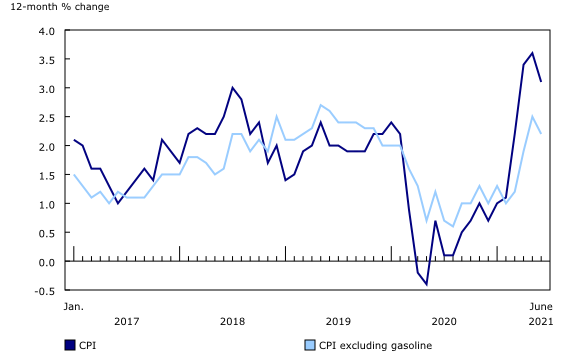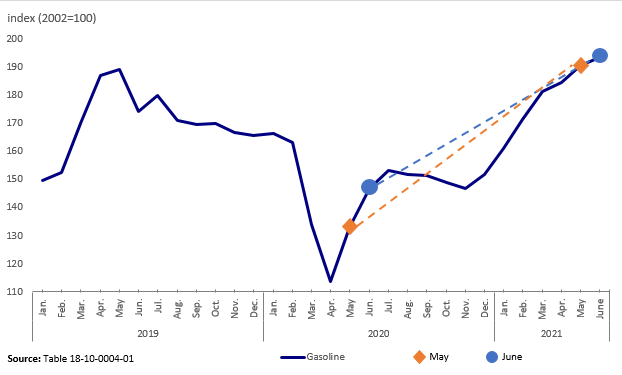Consumer Price Index, June 2021
Archived Content
Information identified as archived is provided for reference, research or recordkeeping purposes. It is not subject to the Government of Canada Web Standards and has not been altered or updated since it was archived. Please "contact us" to request a format other than those available.
Released: 2021-07-28
June 2021
3.1% 
(12-month change)
The Consumer Price Index (CPI) rose 3.1% on a year-over-year basis in June, down from a 3.6% gain in May. As a result of price increases in June 2020, base-year effects had a downward impact on consumer inflation, contributing to the slowdown in June 2021. Excluding gasoline, the CPI rose 2.2% year over year.
The monthly CPI rose 0.3% in June 2021, down from a 0.5% increase in May. On a seasonally adjusted monthly basis, the CPI rose 0.1% in June.
Highlights
While shelter (+4.4%) and transportation (+5.6%) prices contributed the most to the all-items increase, prices rose at a slower pace in four of the eight major components on a year-over-year basis in June. The headline CPI grew at a slower pace compared with May due in part to a slowdown in price growth for goods. Growth slowed the most in the clothing and footwear component, mostly due to lower prices for women's clothing.
Explore the Consumer Price Index
Check out the Personal Inflation Calculator! This interactive calculator allows you to enter dollar amounts in the common expense categories to produce a personalized inflation rate, which you can compare to the official measure of inflation for the average Canadian household — the Consumer Price Index (CPI).
Visit the Consumer Price Index portal to find all CPI data, publications, interactive tools, and announcements highlighting new products and upcoming changes to the CPI in one convenient location.
Check out the Consumer Price Index Data Visualization Tool to access current and historical CPI data in a customizable visual format.
Gasoline prices increase at a slower rate
On a year-over-year basis, gasoline prices rose to a lesser extent in June (+32.0%) than in May (+43.4%) due to a base-year effect. The slower price growth in June stemmed from an increase in June 2020, when gasoline prices partially recovered after falling significantly during the early stages of the pandemic. Gasoline prices rose 10.5% month over month in June 2020, the result of higher demand as businesses gradually reopened.
Shelter costs continue to rise
Year over year growth in shelter costs (+4.4%) continued to increase in June, driven mostly by the continued rise in the homeowners' replacement cost index, up 12.9% in the 12 months to June. Prices for new homes continue to be impacted by shifting consumer preferences as well as higher building costs compared with June 2020.
The other owned accommodation expenses index, which includes commissions and legal fees on the sale of real estate, rose 12.0% year over year in June.
Conversely, the mortgage interest cost index fell 8.6% year over year, the strongest decline on record, as interest rates remained at historically low levels.
Consumers pay less for beef and more for chicken year over year
The fresh or frozen beef index fell 11.1%, compared with June 2020 when beef prices rose 8.3% month over month as a result of reduced supply following plant closures due to COVID-19 outbreaks. The year-over-year drop, the largest yearly decline since 1982, was mainly driven by base-year effects.
In contrast, prices for fresh or frozen chicken rose 10.6% year over year, the largest increase since 2004, as a base-year effect due to lower prices in June 2020 had an upward impact on the index.
On a monthly basis, prices for beef (+0.6%) and chicken (+0.7%) increased compared with May 2021.
Prices for fresh vegetables fall for the fourth consecutive month
The fresh vegetables index continued to trend downwards in June, falling 7.5% year over year — the largest yearly decline since March 2017. This was partially attributable to lower prices for tomatoes (-30.3%) and potatoes (-7.7%) in June. The declines occurred amid increased supply stemming from favourable weather conditions in growing regions.
In addition, the fall in prices for tomatoes was partly driven by a base-year effect as prices rose 16.2% month over month in June 2020 due to lower supply.
Consumers pay less for cellular phone plans and devices
Consumers paid 21.4% less for cellular services on a year-over-year basis in June, following a 17.0% decline in May. The decrease was mainly due to a variety of promotions across the industry offering lower prices for cellular phone plans and bonus data.
Prices for multipurpose digital devices, which include smartphones and tablets, fell 13.7% on a year-over-year basis in June, largely due to industry-wide price promotions for various smartphones.
Spotlight on supply chains
Trade brings many benefits to Canadians, including access to a broader variety of consumer goods. International trade occurs through complex networks of firms—such as manufacturers, distributors, and retailers, among others—who cooperate to produce and deliver finished goods to consumers. This process is known as a supply chain.
The global supply chain has grappled with exceptional challenges as a result of the COVID-19 pandemic. Against a backdrop of input shortages, production bottlenecks, higher shipping costs and delivery delays, and the reopening of some economies, the international flow of raw materials and finished products has experienced disruptions.
Strain on the global supply chain has affected the Canadian CPI in a number of ways. For example, in June 2021, a global shortage of semiconductor chips partly contributed to higher year-over-year prices for passenger vehicles (+4.1%). Prices for household appliances (+5.2%), which includes cooking appliances (+6.3%), refrigerators and freezers (+9.8%), and laundry and dishwashing appliances (+7.1%), also increased year over year in June, as supply chain bottlenecks, including higher shipping costs and delays for imported appliances, put upward pressure on the index.
As Canada and major trading partners gradually reopen, Statistics Canada will continue to monitor supply chain conditions, and the potential impact on consumer price inflation.
Regional highlights
Year over year, prices rose at a slower pace in June than in May in every province.
Price growth slows the most in Saskatchewan
Among the provinces, price growth in Saskatchewan slowed the most year over year in June (+1.8%) compared with May (+2.7%). Much of this slowdown stemmed from lower prices for passenger vehicle insurance premiums (-24.2%), which fell for the second consecutive month, as a rebate for drivers continued from May. Consumers in Saskatchewan also paid less, on a year-over-year basis, for rent (-0.5%) compared with other provinces.
Note to readers
Reddit Ask Me Anything
Do you have questions about the Consumer Price Index, Canadian inflation or what the new CPI basket means for measuring consumer prices? Join us for our Reddit AMA event on July 29, 2021, at 1:30 p.m., Eastern Time.
Basket Update
The basket of goods and services used in the calculation of the Consumer Price Index (CPI) has been updated with the release of the June 2021 data. For the first time, several new sources of expenditure data were used to ensure the new CPI weights reflect evolving consumer spending patterns, particularly as the country transitions from pandemic response to recovery. The new basket weights are based on 2020 expenditure data, which include information on pre-pandemic expenditures, initial pandemic impacts, some recovery data and the emergence of new consumption patterns. The data reflect shifts in spending due to the COVID-19 pandemic that will likely take some time to stabilize across goods and services, and geographic regions.
The new basket weight reference period is 2020, based on the national household final consumption expenditure (HFCE) data, in addition to data from the Survey of Household Spending and provincial HFCE series. Alternative data for 2020 has been used to account for pandemic-related shifts at more detailed levels of geography and CPI components.
The base period, in which the CPI is set to equal 100, remains 2002.
The headline CPI for June 2021 would have been the same using the 2017 basket weights.
For more detailed information, consult the document entitled "An Analysis of the 2021 Consumer Price Index Basket Update, Based on 2020 Expenditures" in the Prices Analytical Series (62F0014M) and the infographic entitled "The Consumer Price Index: Keeping Up with Canadian Consumers".
When will the CPI basket weights be updated again?
Statistics Canada will continue to monitor consumer expenditure patterns during the reopening and recovery period. Another weight adjustment is planned for 2022, to account for post-pandemic spending, and to ensure an even greater degree of relevance. Going forward, Statistics Canada will move towards annual weight updates based on the most recent household expenditure data available. Improvements to the Adjusted Price Index are also underway, with the next publication planned towards the end of 2021.
COVID-19 and the Consumer Price Index
Goods and services in the CPI that were not available to consumers in June due to COVID-19 restrictions received special treatments, effectively removing their impact on the monthly CPI. The following sub-indexes were imputed from the monthly change in the all-items index: travel tours, components of spectator entertainment, recreational services, personal care services in some areas, and some components of use of recreational facilities and services in some areas.
The price indexes for beer served in licensed establishments, wine served in licensed establishments and liquor served in licensed establishments, as well as air transportation received the same treatments as in May.
The details of the treatments from April 2020 to March 2021 are provided in technical supplements available through the Prices Analytical Series. Details and treatments for April 2021 to June 2021 are available upon request.
As COVID-19 restrictions ease throughout the country, products and services that were unavailable for consumption in previous months will start to become available. Statistics Canada continues to monitor the impacted sectors and will remove these special treatments and reintroduce monthly pricing as the goods and services become widely available for consumption.
Real-time data tables
The real-time data table (18-10-0259-01) will be updated on August 9. For more information, consult the document "Real-time tables."
Next release
The CPI for July will be released on August 18.
Products
The "Consumer Price Index Data Visualization Tool" is available on the Statistics Canada website.
More information on the concepts and use of the Consumer Price Index (CPI) is available in The Canadian Consumer Price Index Reference Paper (62-553-X).
For information on the history of the CPI in Canada, consult the publication Exploring the First Century of Canada's Consumer Price Index (62-604-X).
Two videos, "An Overview of Canada's Consumer Price Index (CPI)" and "The Consumer Price Index and Your Experience of Price Change," are available on Statistics Canada's YouTube channel.
Contact information
For more information, or to enquire about the concepts, methods or data quality of this release, contact us (toll-free 1-800-263-1136; 514-283-8300; STATCAN.infostats-infostats.STATCAN@canada.ca) or Media Relations (613-951-4636; STATCAN.mediahotline-ligneinfomedias.STATCAN@canada.ca).
- Date modified:







